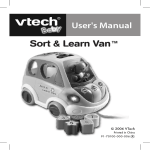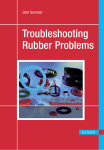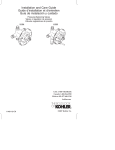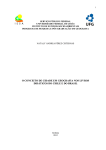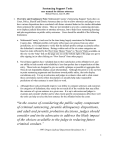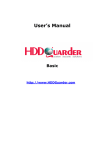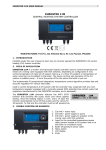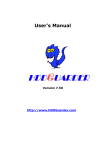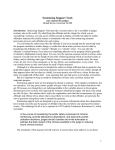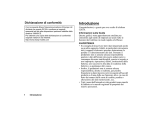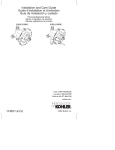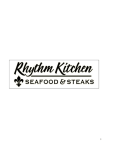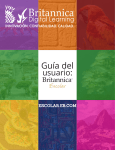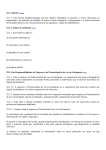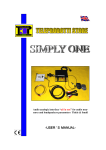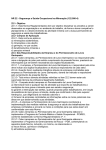Download ToolInstallManual - Children`s Museum of Memphis
Transcript
The Children's Museum of Memphis Toolville User Manual Toolville User Manual MUSEUM CONTACTS 3 EXHIBIT TEXT 4 EDUCATION AND PROGRAMMING 12 MARKETING MATERIALS 17 INSTALLATION MANUAL 18 De-installation 33 Paint/Finish Schedule 34 Crate List 36 Props Inventory 38 Maintenance Checklist 40 ADDITIONAL MATERIALS CLASSROOM ACTIVITIES CONDITION REPORT ARRIVAL CONDITION REPORT DEPARTURE MARKETING DISK USER MANUAL AND EDUCATION DISK Page 2 of 40 Toolville User Manual TOOLVILLE is the property of The Children’s Museum of Memphis 2525 Central Avenue Memphis TN 38104 USA (901) 458-2678 Fax (901) 458-4033 www.cmom.com MUSEUM CONTACTS Exhibit Installation/Education/Maintenance/Props Jim Hyde Exhibits Manager (901) 458-2678 x244 (901) 338-9015 [email protected] PR/Marketing Randy McKeel Director of Marketing (901) 458-2678 x 231 [email protected] Page 3 of 40 Toolville User Manual EXHIBIT TEXT SB = speech bubble (link to cartoon image listed in parenthesis). All speech bubble text in black (Eng.) and gray (Span.) ES = English / Spanish side by side (all other cases, English is on top of Spanish). Sizes are written height x width. Text background color in sections A, B, C, D, and F is PMS 4545 at 40%. Text in section E is printed on black Sintra. * Denotes optional text panels. code Text – English Text – Spanish font style / colors A-1 I'M OLIVE. ME LLAMO OLIVIA. A-2 I'M HENRY. ME LLAMO ENRIQUE. comic sans ms (black, gray) comic sans ms A-3 A-3 <comic strip with 3 frames; insert following text into each frame as written> WE'RE OTTERS. CS-1, frame 1 WE LIVE IN TOOLVILLE. VIVIMOS EN MECANOLANDIA. WE LOVE TO PLAY AND WORK. NOS ENCANTA JUGAR Y TRABAJAR. AND EAT! ¡Y COMER! FOLLOW US THROUGH TOOLVILLE, AND WE'LL SHOW YOU HOW TOOLS HELP US! A-3 CS –1, frame 2 A-3 CS-1, frame 3 A-4 Very few animals use tools, but otters are tool users. This otter is using a rock to crack open a clamshell. A-5 WELCOME TO TOOLVILLE (entire sign 18 x 102) SOMOS NUTRIAS. comic sans ms size in inches (H x W) 12 x 15 12 x 15 18 x 48 (entire strip) 18 x 16 SB, ES SB (O-1) SB (H-1) SB (O, H) comic sans ms 18 x 16 SB (H, O) ¡SÍGUENOS A MECANOLANDIA Y TE ENSEÑAREMOS CÓMO LAS HERRAMIENTAS NOS AYUDAN! Muy pocos animales usan herramientas, pero las nutrias las usan. Esta nutria usa una roca para abrir una almeja. comic sans ms 18 x 16 SB (H) informal, 5135 / 5145 18 x 18 BIENVENIDOS A MECANOLANDIA (Spanish on 6 x 60, attached w/ Velcro) informal, 032 sign 18x 102, Span. on 6 x 60 Page 4 of 40 Toolville User Manual code Text – English Text – Spanish font style / colors size in inches A-6 THE SIMPLE SIX LOS SIMPLES SEIS 15 x 36 There are six simple tools. Existen seis mecanismos simples que se usan como herramientas. informal, 5135 / 5145 A-7 Pulley Polea informal, 2592 6 x 12 A-8 Wedge Cuña informal, 347 6 x 12 A-9 Wheel Rueda informal, 032 6 x 12 A-10 Lever Palanca 6 x 12 A-11 Inclined Plane Plano Inclinado informal, reflex blue informal, 151 A-12 Screw Tornillo informal, 012 6 x 12 A-13 Toolville sponsored by <insert home depot logo> In-Kind support provided by Black & Decker® Radio Flyer® and Fabulous Fiddlestix Gearworks® by Toys-N-Things This exhibition was produced by The Children's Museum of Memphis for the members of the Youth Museum Exhibit Collaborative: Mecanolandia auspiciado por informal, 5135 / 5145 36 x 18 informal, 5135 / 5145 36 x 18 A-14 Bay Area Discovery Museum Brooklyn Children’s Museum Canadian Children’s Museum Chicago Children’s Museum The Children's Museum of Houston The Children's Museum of Indianapolis The Children's Museum of Memphis Minnesota Children’s Museum Con el generoso apoyo de Esta exhibición fue producida por The Children's Museum of Memphis para los miembros de la Youth Museum Exhibit Collaborative: Bay Area Discovery Museum Brooklyn Children’s Museum Canadian Children’s Museum Chicago Children’s Museum The Children's Museum of Houston The Children's Museum of Indianapolis The Children's Museum of Memphis Minnesota Children’s Museum Page 5 of 40 (H x W) 6 x 12 SB, ES Toolville User Manual code Text – English Text – Spanish font style / colors size in inches CAC moose, 5135 / 5145 informal, 5135 / 5145 9 x 15 informal, 5135 / 5145 CAC moose, 5135 / 5145 informal, 5135 / 5145 3 x 18 informal, 5135 / 5145 CAC moose, 5135 / 5145 informal, 5135 / 5145 9 x 30 12 x 42 ES ES (H x W) B-1, B-4, B-7, B-10, B-16, B-21 all in CAC Moose in SAME font size Wedge Cuña B-2 A wedge is a V-shaped object that we use to split or pry things apart. Una cuña es un objecto en forma de V que se usa para partir o para abrir cosas. B-3 Which part of the ax is a wedge? ¿Qué parte del hacha es una cuña? B-4 WHEEL RUEDA B-5 We use wheels when we drive our cars, roll out dough and skate! ¡Usamos ruedas cuando manejamos nuestros automóviles, cuando amasamos masa y cuando patinamos! B-6 Gears are one kind of wheel. El engranaje es un tipo de rueda. B-7 INCLINED PLANE PLANO INCLINADO B-8 An inclined plane is a flat surface that is higher or thicker on one end. We use inclined planes to move something from a lower level to a higher level or from a higher level to a lower level. Un plano inclinado es una superficie plana con un extremo elevado o más grueso. Usamos planos inclinados para mover cosas desde un nivel bajo a un nivel alto o de un nivel alto a un nivel bajo. B-9 Pull each wagon. Which one feels lighter? Tira de cada vagoneta. ¿Cuál se siente más liviana? informal, 5135 / 5145 6 x 27 B-10 LEVER PALANCA 9 x 15 B-11 * A lever helps you move things. La palanca te ayuda a mover cosas. CAC moose, 5135 / 5145 informal, 5135 / 5145 note B-1 Page 6 of 40 SB, ES 6 x 18 9 x 15 18 x 9 9 x 24 12 x 36 Toolville User Manual code Text – English Text – Spanish font style / colors size in inches B-12 σ A fulcrum is a point where the lever turns. σ Un fulcro es un punto donde la palanca gira. informal, 5135 / 5145 15 x 15 informal, 5135 / 5145 9 x 15 informal, 5135 / 5145 informal, 5135 / 5145 9 x 15 CAC moose, 5135 / 5145 informal, 5135 / 5145 9 x 15 informal, 5135 / 5145 24 x 15 comic sans ms, black / gray 12 x 15 SB (H-2) comic sans ms 15 x 21 SB (O) CAC moose, 5135 / 5145 informal, 5135 / 5145 9 x 15 A force is a push or pull. ν A load is the weight of the object to be moved. Fuerza es un empujón o un ν Una carga es el peso de un objeto a ser movido. La pala es una palanca de 1ra clase. The shovel is a 1st class lever. B-14 La carretilla de mano es una palanca de 2da clase. B-15 The wheelbarrow is a 2nd class lever. The broom is a 3rd class lever. B-16 SCREW TORNILLO B-17 A screw is an inclined plane wrapped around a cylinder or cone shape. We use screws to hold things together. When you get home, see how many things you can find that are held together by screws. This device is called "Archimedes' screw." It can be used to lift things. WHO IS ARCHIMEDES AND WHY IS THIS HIS SCREW? HE WAS THE ANCIENT GREEK SCIENTIST SAID TO HAVE INVENTED IT, BUT SOME SAY THIS TYPE OF SCREW WAS AROUND BEFORE HIS TIME. La escoba es una palanca de 3ra clase. B-21 PULLEY Un tornillo es un plano inclinado enroscado alrededor de un cilindro o un cono. Usamos tornillos para armar cosas. Cuando vayas a casa, mira a ver cuántas cosas puedes encontrar que están ensambladas con tornillos. Este aparato se conoce como "el tornillo de Arquímides." Puede ser usado para levantar cosas. ¿QUIÉN ES ARQUÍMIDES Y POR QUÉ ES ESTE SU TORNILLO? SE DICE QUE ÉL FUE UN CIENTÍFICO DE LA GRECIA ANTIGUA E INVENTOR DE ESTE TORNILLO, PERO OTROS DICEN QUE ESTE TIPO DE TORNILLO YA EXISTÍA DESDE ANTES. POLEA B-22 * Which one is easiest to lift? ¿Cuál es más fácil para levantar? B-19 (H) B-20 (O) (H x W) tirón. B-13 B-18 SB, ES Page 7 of 40 9 x 15 36 x 18 9 x 18 Toolville User Manual code Text – English Text – Spanish font style / colors size in inches C-1 Toolville Toy Store Juguetería de Mecanolandia market, 187, 184 12 x 72 ES C-2 Did you know tools can help you play? There are tools in many of our toys. ¿Sabías que las herramientas nos ayudan a jugar? En nuestros juguetes podemos encontrar herramientas. informal, 187, 184 9 x 54 ES C-3 THINK OF TOYS YOU HAVE AT HOME THAT USE SIMPLE TOOLS. PIENSA EN LOS JUGUETES QUE TIENES EN CASA QUE USAN HERRAMIENTAS SIMPLES Y QUE TE AYUDAN A JUGAR. comic sans ms, black / gray 15 x 30 SB (H-4) C-4 Push and hold each button to find the tools in these toys. Oprime cada botón para encontrar las herramientas en estos juguetes. informal, 187, 184 24 x 15 code Text – English Text – Spanish font style / colors size in inches D-1 Central Park Parque Central 18 x 24 D-2 * What happens when you try to lift someone who is heavier than you? Try using this simple tool to do the job. ¿Qué pasa cuando tratas de levantar a alguien que es más pesado que tú? Trata de usar esta herramienta simple para hacer el trabajo. market, 3425 / 3385 informal, 3425 / 3485 Page 8 of 40 SB, ES (H x W) SB, ES (H x W) 24 x 24 (seesaw graphic at sign bottom) ES Toolville User Manual code Text – English Text – Spanish font style / colors size in inches E-1 Tools can help us work. Las herramientas nos ayudan a trabajar. 18 x 18 E-2 KEEP THE CONSTRUCTION SITE SAFE. PUT THINGS BACK WHERE THEY BELONG. MANTENGAMOS SEGURO EL LUGAR DE CONSTRUCCIÓN. PONGAMOS LAS COSAS DE VUELTA EN SU LUGAR. informal, white / gray on black Sintra comic sans ms, black / gray 15 x 27 SB (O-8) E-3 THERE ARE MANY JOBS ON A CONSTRUCTION SITE. YOU CAN BE AN ARCHITECT, CONSTRUCTION WORKER, WELDER, BACKHOE DRIVER OR CONTRACTOR. CAN YOU THINK OF SOME OTHER CONSTRUCTION JOBS? HAY MUCHOS EMPLEOS EN UN LUGAR DE CONSTRUCCIÓN. PUEDES SER ARQUITECTO, OBRERO/A, SOLDADOR/A, CHOFER O CONTRATISTA. ¿PUEDES PENSAR EN OTROS EMPLEOS DE LA CONSTRUCCIÓN? comic sans ms, black / gray 24 x 30 SB (H-6) E-4 Always wear a hard-hat and safety goggles when working. Siempre utiliza casco y gafas protectoras cuando trabajes. 12 x 24 E-5 Construction vehicles help the crew do some very hard work that they couldn't do without tools. Los vehículos de construcción ayudan al equipo a hacer trabajos arduos que no podrían hacer sin el uso de herramientas. informal, white / gray on black Sintra informal, white / gray on black Sintra 18 x 24 ES E-6 Olive Otter Henry Otter General Contractors Olivia Nutria Enrique Nutria Contratistas Generales architect, white / gray on black Sintra 12 x 18 ES Page 9 of 40 SB, ES (H x W) Toolville User Manual code Text – English E-7 Comic strip (CS-2), 4 frames, insert text as directed. E-7 A SIMPLE TOOL IS A DEVICE THAT MAKES WORK EASIER. UNA HERRAMIENTA SIMPLE ES UN ARTEFACTO O MECANISMO QUE FACILITA UN TRABAJO. LIKE WHEN I MOVE A PILE OF BRICKS, IT'S EASIER WHEN I USE A WHEELBARROW. IT'S LESS WORK. POR EJEMPLO, CUANDO TENGO QUE MOVER UN PILA DE LADRILLOS, ES MÁS FÁCIL SI USO UNA CARRETILLA. ES MENOS TRABAJO. WORK IS DONE WHEN WE USE FORCE TO MOVE SOMETHING. UN TRABAJO SE HACE CUANDO SE USA FUERZA PARA MOVER ALGO. SOUNDS LIKE A JEDI MIND TRICK. ESO SUENA COMO A UN TRUCO MENTAL DE LOS JEDI. NO OLIVE, FORCE IS A PUSH OR A PULL. NO OLIVIA, FUERZA ES UN EMPUJÓN O UN TIRÓN. SO WHEN I USE A TOOL TO MOVE SOMETHING, I CAN USE LESS FORCE. ASÍ QUE CUANDO USO UNA HERRAMIENTA PARA MOVER ALGO, PUEDO USAR MENOS FUERZA. EXACTLY! YOU DON'T HAVE TO PUSH OR PULL AS HARD WHEN YOU USE A TOOL. ¡EXACTO! NO TIENES QUE ESFORZARTE TANTO EN EMPUJAR O TIRAR CUANDO USAS UNA HERRAMIENTA. CS-2, frame 1 E-7 CS-2, frame 2 E-7 CS-2, frame 3 E-7 CS-2, frame 4 IN OTHER WORDS, TOOLS HELP US! Text – Spanish EN OTRAS PALABRAS, ¡LAS HERRAMIENTAS NOS AYUDAN! Page 10 of 40 font style / colors comic sans ms, black / gray size in inches SB, ES (H x W) 12 x 48; each frame 12 x 12 12 x 12 SB (H, O) comic sans ms, black / gray 12 x 12 SB (H, O) comic sans ms, black / gray 12 x 12 SB (H, O) comic sans ms, black / gray 12 x 12 SB (H, O) Toolville User Manual code Text – English Text – Spanish font style / colors size in inches F-1 PIER 6 MUELLE 6 market, 634 / 631 2 signs, Eng: 6 x 18 Span: 6 x 24 F-2 I WANT A HALF-POUND OF CLAMS. HENRY WANTS ONE POUND. QUIERO MEDIA LIBRA DE ALMEJAS. ENRIQUE QUIERE UNA LIBRA. comic sans ms, black / gray 12 x 15 SB (O-9) F-3 CAN YOU WEIGH OUT ENOUGH FOR BOTH OF US? ¿PUEDES PESAR UNA CANTIDAD SUFICIENTE PARA AMBOS? comic sans ms 12 x 15 SB (H-7) F-4 * OTTERS NEED A LOT OF FOOD BECAUSE WE ARE ALWAYS SWIMMING AND PLAYING. WE EACH EAT ABOUT 10 TO 15 POUNDS OF FOOD EVERY DAY. NOSOTRAS LAS NUTRIAS NECESITAMOS MUCHO ALIMENTO PORQUE NOS LA PASAMOS NADANDO Y JUGANDO. CADA UNA DE NOSOTRAS COME ALREDEDOR DE 5 A 7 KILOGRAMOS DE ALIMENTO CADA DÍA. comic sans ms 24 x 30 SB (O-10) Page 11 of 40 SB, ES (H x W) Toolville User Manual EDUCATION AND PROGRAMMING Classroom Activity Guide A Toolville classroom guide for teachers and group leaders is found at the end of this manual (APPENDIX A). Science experiments with low-cost or recycled materials and tool-related activities linked to other curriculum areas are featured. National, state and local science curriculum standards are addressed in the curriculum guide. Programming Ideas The following programming ideas were selected from the most successful Toolville programs offered during the exhibit’s Memphis run. Educator-led Program: Motion Commotion Contains experiments demonstrating each of Newton’s 3 Laws of Motion Experiment 1: Crash Test Demonstrates Newton’s 1st Law of Motion: Without a force (push or pull), an object either stays still or keeps moving in a straight line or at the same speed. (Remember, friction and gravity are forces.) Materials needed: • small wagon • baseball Instructions: 1. Start with the baseball in the wagon touching the back. 2. Ask the child: Why is the wagon not moving? How could you get it to move? (use a force: push, pull or lift) 3. Pull the wagon then stop it suddenly. What happens to the baseball? (it keeps rolling) Why? (something called inertia) 4. Ask: What happens when you're riding in a car and the driver suddenly brakes? Discuss the need for seatbelts and/or airbags. 5. Explain Newton's 1st law of motion or have the child explain it to you. Experiment 2: Catapult Demonstrates Newton’s 2nd Law of Motion: A force on an object makes it move or changes how it moves. The greater the force, the greater the movement or change in movement. Materials needed: • small “catapult” – this can be made with a paper towel roll as a fulcrum and a 12” ruler as a lever; tape a bathroom-sized paper cup to the ruler to hold the ball • ping-pong ball Instructions: 1. Place the ping-pong ball in the cup of the catapult. 2. Ask the child: What would happen if I pushed down on the handle slowly? What if I pushed very hard and fast? 3. Push the handle down first slowly, then quickly. Let the child try too. What happens to the ping-pong ball? Why? (see Newton's 2nd law) Page 12 of 40 Toolville User Manual 4. 5. Ask: How does Mark McGuire or Sammy Sosa hit the baseball out of the ballpark? (the greater the force the greater the movement) To the child: They're coming at you ... and fast! Which would you rather stop: a ping-pong ball or a bowling ball? Experiment 3: Marbles in Motion Demonstrates Newton’s 3rd Law of Motion: For every action, there is an equal and opposite reaction. Materials needed: • 8 marbles • 2 flat pieces of track from a toy raceway • a small box Instructions: 1. Place one piece of track on a flat surface and other on the box so that one end of the track lines up with the flat track (end to end). Place the marbles in the middle of the flat track. Place one marble at the top of the ramp. Before letting it go, ask the child to predict what will happen to the marbles on the flat track. Now let the marble go. 2. Ask your child: Why did only one marble move? (the action of the one dropped marble caused an equal but opposite reaction in the marble that moved) 3. Ask: What would happen if I dropped two marbles? Try this and see if they were able to guess what would happen. 4. Ask the child to think about a shuttle launch. How does the shuttle get off the ground? The engines exert a huge force on the ground that makes the shuttle rise. The engines create an action that causes an equal and opposite reaction. Educator-led Program: Science Friction Experiment 1: What is Friction? Materials needed: • rubber mat • 2 jar lids • 5 marbles Instructions: 1. Ask the child to think about having cold hands. You can rub them together to warm them up. Get the child to rub his/her hands together and feel the heat this generates. Tell the child that friction is caused by two surfaces rubbing together, like your hands. 2. Friction creates heat. It can also stop or slow down a moving object. A rolling ball stops because of the friction caused by the surface of the ball touching the ground. 3. Place the jar lids on the rubber mat, one directly on the mat, one with the marbles underneath. Tell the child these objects aren’t heavy, but pretend they are furniture or some other heavy object. Ask the child to push one, then the other across the mat’s surface. Why is one easier to push? The marbles act like wheels or ball bearings to reduce the friction and make the work easier. 4. Wheels help overcome friction and make things easier to move. But how do we slow down a moving object, like a bike or car? We use brakes to create friction! Page 13 of 40 Toolville User Manual Experiment 2: Friction 500 Materials needed: • ramp (this can be a flat piece of wood) • various materials such as fabric, carpet, wax paper, a rubber mat, etc. • toy vehicle • measuring tape Instructions: 1. Place the vehicle at the top of the ramp. 2. Ask the child to make predictions about which material on which they think the vehicle will travel the farthest distance, the shortest distance, etc. 3. Test one surface material at a time. Be careful to start the vehicle from the same spot each time and let it go rather than pushing it down the ramp. 4. Measure the distance for each surface material and compare to the predictions. 5. Explain: Objects move easier when there is less friction. In fact, things could move along forever if there was no friction. Once something gets moving, it gains momentum. It keeps moving unless it is stopped by something else (Newton’s 1st law of motion). Because friction is what stops the momentum, the surface that lets the vehicle to go the shortest distance would be the one with most friction. Educator-led Program: Tools in Your Toys Materials needed • various small toys with simple machines in them {some suggestions are wagon (wheels), Viewmaster (lever, wheel), spiral race track (inclined plane), etc.} • bulletin board set or laminated cards with the 6 simple machines (or do this in the Entry Arch of Toolville and use the “Simple Six” labels) Procedures: 1. Start by introducing yourself and welcoming the visitors to the exhibit. 2. Ask if anyone knows the “Simple Six” or the 6 simple machines. 3. Use the exhibit labels or laminated cards to introduce each of the simple machines. Ask for examples of each that the visitors may have seen or used themselves. 4. Ask the visitors: “Did you know that the “Simple Six” can help us play? Some of our toys have simple machines in them.” (If in the exhibit you can point out examples from the Toy Store or Central Park) 5. Show the collection of small toys one at a time and get the visitors to find the simple machines within them. After this is done, get them to look for simple machines in all areas of the exhibit. Educator-led Program: Mechanical Advantage (Can also use the seesaw in Central Park and the Pulley Demo in the Welcome Center to expand on this demonstration) Materials needed: • wood or cardboard box about 12” in height • wood plank, 3 feet long and approx. 8 – 10” wide • small wagon • 4 soda cans (or any weight that will fit in wagon’s bed) • spring scale that goes up to 4 pounds Page 14 of 40 Toolville User Manual • measuring tape Procedures: 1. Have all the materials set out on a table in front of you. 2. Begin by showing the spring scale. Tell the visitors that this is an instrument used to measure weight. Ask what it is (a scale). Tell them that it measures weight, but can also measure force. Pull on the scale and show them that the harder you pull, the more force registers on the spring scale. 3. Weigh the wagon and the cans using the spring scale. Get the visitors to add the weights together to get the total weight of wagon and cans. Tell them that to pick up the wagon and cans and put them on top of the box, you will have to use ____ pounds of force. Put the wagon on top of the box, then place it back on the table. 4. Ask if there is another way to get the wagon to the top of the box using less force. If you need to give a hint, tell them they can use something that’s on the table. Someone will guess or know to use the wood plank as a ramp. Ask what simple machine the ramp is (inclined plane). 5. Tell them that they’ve made a hypothesis, or a guess, that less force will be used and that now you will test the hypothesis. Using the spring scale, slowly pull the wagon up the ramp, getting someone to observe how much force is being used. 6. Say that using a simple machine makes it easier to lift the wagon, but there’s a catch. Measure the distance from the tabletop to the top of the box (1 foot), and then measure the ramp’s length (3 feet). Tell them that with the ramp you were able to use less force, but had to go a longer distance. This is a “trade-off” called mechanical advantage. Making the distance longer made it easier to lift the wagon: it required less force. 7. To sum up, mechanical advantage means, “longer is easier.” You can demonstrate this again using the seesaw and moving the plank to change the fulcrum point or with the pulley demo. Program: Tools in Your Toys Materials needed • various small toys with simple machines in them (can use the Toy Store shelf toys) • bulletin board set or laminated cards with the 6 simple machines (or do this in the Entry Arch of Toolville and use the “Simple Six” labels) Procedures: 6. Start by introducing yourself and welcoming the visitors to the exhibit. 7. Ask if anyone knows the “Simple Six” or the 6 simple machines. 8. Use the exhibit labels or your own laminated cards to introduce each of the simple machines. Ask for examples of each that the visitors may have seen or used themselves. 9. Ask the visitors: “Did you know that the ‘Simple Six’ can help us play? Some of our toys have simple machines in them.” (If in the exhibit you can point out examples from the Toy Store or Central Park) 10. Show the collection of small toys one at a time and get the visitors to find the simple machines within them. After this is done, get them to look for simple machines in all areas of the exhibit. Program: Mechanical Advantage (Can also use the seesaw in Central Park and the pulley demo in the Welcome Center to expand on this demonstration) Materials Needed • wood or cardboard box about 12” in height • wood plank, 3 feet long and approx. 8 – 10” wide • small wagon • 4 soda cans (or any weight that will fit in wagon’s bed) Page 15 of 40 Toolville User Manual • • spring scale that goes up to 4 pounds measuring tape Procedures: 8. Have all the materials set out on a table in front of you. 9. Begin by showing the spring scale. Tell the visitors that this is an instrument used to measure weight. Ask what it is (a scale). Tell them that it measures weight, but can also measure force. Pull on the scale and show them that the harder you pull, the more force registers on the spring scale. 10. Weigh the wagon and the cans using the spring scale. Get the visitors to add the weights together to get the total weight of wagon and cans. Tell them that to pick up the wagon and cans and put them on top of the box, you will have to use ____ pounds of force. Put the wagon on top of the box, then place it back on the table. 11. Ask if there is another way to get the wagon to the top of the box using less force. If you need to give a hint, tell them they can use something that’s on the table. Someone will guess or know to use the wood plank as a ramp. Ask what simple machine the ramp is (inclined plane). 12. Tell them that they’ve made a hypothesis, or a guess, that less force will be used and that now you will test the hypothesis. Using the spring scale, slowly pull the wagon up the ramp, getting someone to observe how much force is being used. 13. Say that using a simple machine makes it easier to lift the wagon, but there’s a catch. Measure the distance from the tabletop to the top of the box (1 foot), and then measure the ramp’s length (3 feet). Tell them that with the ramp you were able to use less force, but had to go a longer distance. This is a “trade-off” called mechanical advantage. Making the distance longer made it easier to lift the wagon: it required less force. 14. To sum up, mechanical advantage means, “longer is easier.” You can demonstrate this again using the seesaw and moving the plank to change the fulcrum point or with the pulley demo. Page 16 of 40 Toolville User Manual MARKETING MATERIALS A marketing disk can be found in Additional Materials section at the end of this manual. It includes sample media releases, exhibit photos, and other files that will be helpful in marketing the exhibit locally. Page 17 of 40 Toolville User Manual INSTALLATION MANUAL NOTE: As crates are unpacked, please save all packing materials and reuse. Please complete “condition report – arrival” (Additional Materials) as the exhibit is unpacked and installed. GENERAL NOTES Bolts, screws, and any other attaching devices for exhibit components are either already inserted into their proper location in one of the pieces to be attached, or are in plastic bags attached to the component. Five electrical plugs are needed for exhibit components: four in the Toy Store and one in the Construction Site. CRATES There are 31 crates. There is no Crate 23, so crates number through 32. Each crate is marked with orange dots; these dots show the bolts that are to be removed to open the crate; no other bolts should be removed. All crates should be opened with the skids on the bottom. PANELS Panels in the Toolville exhibit serve to help create a “town” look by delineating areas of the town and depicting scenes; they also provide structures for securing some components and provide space for display of copy and graphics. Toolville consists of six areas: Entry Arch, Welcome Center, Toolville Toy Store, Central Park, Construction Site, and Pier Six. Use the ground plan to do preliminary planning of where you will place each of the areas in your space and which of the optional configurations of panels you will use. Each of the 6 areas can stand alone, and therefore can be placed as best fits your space, although of course the Entry Arch and Welcome Center need to be at an entry spot. Also, if you want to attach the saw bench to the back of the ax panel for mutual stability (attachment explained later), the Welcome Center and Central Park need to be adjacent to each other. Panels are joined with cam locks; male/female hardware pieces are in the same place on each panel. To allow for varying configurations of space in YMEC museums, some panels can be placed in varying configurations. Some panels can be left out if desired, or placed perpendicular to other panels rather than flat with them. In areas where this is an option, this manual so indicates, and the panels and trim pieces are labeled accordingly. End caps are provided so that “walls” can be finished even if configured other than as they were at CMOM. In Central Park and Pier Six, scenery is painted so that panels can be deleted without disrupting the scene. When you are ready to set up the exhibit, unpack the panels first, which are in Crates 1 - 7 and Crate 32. Panels that are in each of these crates are noted in the attachment to the crate list. Panel numbers are on top of each panel and correspond to the numbering on the ground plan and the elevation drawings. Trim in each of the four areas Welcome Center, Toy Store, Central Park, and Pier Six has a different color of stain on the top and bottom trim of the panels: Area A: Entry Arch – No colored trim Area B: Welcome Center – Purple Area C: Toy Store – Pink Area D: Central Park – Green Area E: Construction Site – No colored trim Area F: Pier Six – Blue Page 18 of 40 Toolville User Manual Panels are lettered/numbered consecutively, so that if all panels are used, the first panel on the left as you face the area will be Panel A-1 and Panel A-2 will connect to it, etc. As an example, the photo below shows how panel D-5 connects to panel D-6. However, start with two corner panels for stability. Place the bottom trim first (labeled inside; top trim says “Top”; bottom trim says “Bottom”). Horizontal arrows indicate that pieces are to be placed in an endto-end application; perpendicular arrows indicate a corner. (see photo below) Trim pieces do not lock together. After the bottom trim pieces are placed, insert panels into the trim and lock panels together with Allen wrench (provided--taped to edge of panels in several crates). Place top trim last. NOTE: Labels, photos, and graphics are also identified with the A, B, C, D, E, F letters corresponding to their respective areas as listed above. When you are installing panels, ignore the letter-number combinations on the front of panels that show you where labels, etc. go, until you get ready to actually place labels. Then these notations show you exactly where each label goes, but until then the notations are extraneous. Labels, photos, and graphics are all in Crate 8. Page 19 of 40 Toolville User Manual ENTRY ARCH The Entry Arch consists of Panels A-1 through A-7. Two 4’x8’ panels will be installed on the left, making an 8’ wide wall, holding the Otter Introduction graphics. The same configuration on the right holds the Simple Six Introduction graphics. Perpendicular to these walls are the 2’x8’ panels, with one displaying sponsor signs and the other, the YMEC credit panel. Page 20 of 40 Toolville User Manual Place panels in this order: A-2 and A-3 in their location, A-5 and A-6 in theirs, then connect A-3 to A-5 by placing A-4 which is an 88” header piece with the 103” Welcome to Toolville sign attached to it. The header piece and the sign are attached together, making it one piece. Then place A-1 and A-7. (see photo below) Page 21 of 40 Toolville User Manual WELCOME CENTER As crates are unpacked, please save all packing materials and reuse. There are 12 panels for the Welcome Center, Panels B-1 through B-6 and D-9 through D-14. IMPORTANT NOTE: Panels D-9 through D-14 are actually part of the Welcome Center rather than Central Park as their letter would imply. Also note the panel that the wedge (ax) is attached to is not numbered. Crates 9, 10, 11, and 12 contain Welcome Center components. One component, the directional pole, is in Crate 26. (Crate 11 also contains the light boxes which go into the Toy Store.) The gear/inclined plane station is a free-standing component (Panels B-5 and B-6, which are attached together as one panel). (See photos below) The Welcome Center arch connects to the top of the unit and this component should be oriented toward the Entry Arch. Place the Welcome Center sign on top of the gear/inclined plane station using screws inserted from the top. Place the Archimedes screw near Panels B-1 and B-2. The ax should be oriented toward the Welcome Center with its back against the wall. The free-standing components can be placed in varying positions but need to be in as close proximity to one another as feasible to help show that they make up one area. Archimedes screw: Balls are packed separately, in a plastic caddy in same crate. Use an Allen wrench to open the acrylic box at the top of the screw and drop the balls in. Do not insert more than 4 balls. The balls will occasionally get stuck somewhere and lose their round shape. In this case, remove the damaged ball. You can access them from the top box or the bottom of the acrylic tube, but try if at all possible to do so from the top. If you must access the place where the balls enter the screw at the bottom of the acrylic Page 22 of 40 Toolville User Manual tube, do so carefully. We tried using a larger number of balls many times, but they got stuck much more often; 4 is the optimum number though not as much fun. Pulley comparison: Will not be disassembled for shipping; it will lie flat in its crate, which will unlock from around it so that the unit can be stood up and put in place. It is very heavy and may require 4 people to move it. In Memphis we placed the unit in front of Panels D-10, 11, and 12. An L-bracket should attach the top of the pulley comparison unit to a panel. We attached it to Panel D-11. During the run of the exhibit, periodically check and tighten all cable connections. Gears: To attach gear box to panel, bring hinged piece perpendicular to back of gear box. Attach left and right wall brackets to left and right ends of gear box using 2” coarse sheet rock screws. Attach entire unit to panel using 6 screws, which are on the hinged piece. Inclined plane station: No assembly required. Ax: No assembly required. Levers: Attach the three lever examples (shovel, wheelbarrow, and broom) to Panels B-3 and B-4 using aircraft cable and eye-bolts. Screw in eye-bolts,and place the shovel tether first on the left using the hole that is approximately 2’ from the bottom trim, the wheelbarrow tether in the middle approximately 1” from bottom trim, and the broom tether third approximately 2’ from bottom trim.) Flag pole: Attach to panel D-14. Put the two long sections of the flag pole together; put the two brackets on the panel. Put top endcap on, lift pole and put bottom endcap on (rope will give enough for endcap to go in place). Directional sign post: Place in Welcome Center area wherever there is space to do so. Note that the signs themselves insert into slots in the nail-shaped dowels which can be placed in varying holes so that the directions can be correct wherever you place the different areas of Toolville. Page 23 of 40 Toolville User Manual TOOLVILLE TOY STORE As crates are unpacked, please save all packing materials and reuse. This area needs four 110 v grounded plugs, to accommodate the light boxes and the viewmaster. The Toy Store has Panels C-1 through C-10. Crates 13, 14, 15, and 16 contain Toy Store components. After the panels are set up, install the baseball bat light box on Panel C-2, the fire truck light box on Panels C-3 and C-4, and the spinning top and viewmaster light box on Panel C-4 . Remove the wood strip from the panel, slide the light box onto the bracket, and reattach the wood strip. The train track light box goes on Panel C-8 and attaches differently: attach to panel with toggle bolts. The fire truck should be positioned on the floor near the corresponding light box, being sure to leave at least 32” so that the push buttons on the light boxes are wheelchair accessible. Use the same principle with the Viewmaster and the train track. The train track is turned upside down inside its table. Remove it, turn it upright, and place it on the table. The train track pieces that are left together are glued together. Loose parts are in the plastic bin in the same crate. Page 24 of 40 Toolville User Manual Open the back of the large Viewmaster piece to access the electrical cord and the light bulbs (key attached to back for shipping). Light bulbs are F8T5 flourescent bulbs. You do not access the Viewmasters themselves from the back. If you need to change out viewmasters (two extras in Crate 13) or Viewmaster reels (extras taped inside back of large Viewmaster piece), remove round acrylicand-white-PVC piece from the plywood piece. DO NOT REMOVE ACRYLIC FROM PVC. Attach the two shelves to the lower part of Panel C-10. Place the toys (animal-binoculars, xylophone, pullalong toy, bus, and pony carousel) on the shelves. Page 25 of 40 Toolville User Manual CENTRAL PARK As crates are unpacked, please save all packing materials and reuse. Panels D-0 through D-8 are available for use in Central Park. This is an area where optional alternate configuring can be done with the panels. If you want to separate Areas C and D, there is an endcap for Panel D-0. If you would like to shorten the space, you may leave out Panel D-4 and attach D-3 to D-5 at a right angle. If you want to separate Area D and E, there is an endcap for D-8. Climbing structure/slide: The “steps” that make up the climbing structure are separated for shipping; even the tops of the steps are disassembled. For these instructions, the seven steps that make up the climbing structure will be called step bases, lettered A through G smallest to largest. Each side of a step base where attachments are made are lettered, and step bases attach in sequence. To assemble the climbing structure, start by attaching G-Left post-and-rail to the angle iron, which stays on slide/bolt unit. Next, place Step Base G (the tallest one) against slide/bolt unit underneath the entrance to the slide. One person must go inside Step Base G and attach Step Base G to slide using 3 carriage bolts. To attach G-Right rail, one person should place bolts through the post, the angle iron, and the step base. Another person inside Step Base G tightens the nuts. Attach Step Base F to Step Base G. Attach post-and-rail A to Step Base F. Remaining step bases should be attached next, in backward alphabetic order (E, D, C etc.), but do not place step tops yet. Next, attach Post-and-Rail E to Step Base E, Post & Rail-C to Step Base C, and Rail D to Post C and Post E. Attach Post E to Post G-Left using L-bracket. Attach Post A to Post G-Right in same manner. Put tops of step bases on last, beginning with A. Corners of step bases are numbered 1, 2, and 3 and correspond to numbers inside tops. Page 26 of 40 Toolville User Manual Screws needed for fastening tops to step bases (1 ½” course sheetrock screws) are taped inside their respective step bases. The final step is to place the yellow acrylic bolt top on top of the slide enclosure unit. The spiral slide assembly attaches to Step Base G as shown. Page 27 of 40 Toolville User Manual The completed slide: Close-up: Seesaw: Place the plywood base, then the seesaw, then the 4 rubber flooring pieces at the base. Saw bench: Remove from crate and set in place. Sit-n-Spin: Remove from crate and set in place. Hammer bench: Remove from crate and set in place. Page 28 of 40 Toolville User Manual CONSTRUCTION SITE As crates are unpacked, please save all packing materials and reuse. The panels of the Construction Site, E-1 through E-8, are made of brick Masonite at the top and T-111 at the bottom. They attach by cam locks, in the same way and sequence as all other panels. Crates 26, 27, and 28 contain components for this area, which are the building frame, the crane, the elevator, the shelf with dress-up items, and the container with tools, building pieces, and construction figures. The crane and the elevator attach to the building frame. Plastic “Briks,” construction hats, and construction vehicles were placed inside the building for shipping. Remove the “Briks” while you have the acrylic end pieces off for installing the crane (see below). Remove the other items and place the hats on the wooden shelf and the construction vehicles and “Briks” near the site. Set the building frame in place first. The part where there is a gap in the acrylic is the back of the building, opposite is the front, and the other two sides are the ends. Set the vertical part of the crane at the gap in the acrylic. Page 29 of 40 Toolville User Manual Remove the two end pieces of acrylic to get access inside but do not remove any other acrylic. Bolt the crane to the back of the building. Set the boom of the crane (horizontal part) on top of the cab (the mustard-colored box). Attach using 6 bolts, which are in their proper location in the crane. Remove the bolts that are in the counterbalance weight, slide the weight into its slot, and bolt the weight in using the threaded inserts. Connect the cable to the hook and tighten the turnbuckle. Reattach the acrylic side pieces of the building. The electrical cord powering the boom is inside the cab and is accessed from the top. Jib control (for changing the speed of panning) is also inside cab. The winch is inoperable. Page 30 of 40 Toolville User Manual Set the elevator beside the building at the rear corner. Attach the top horizontal flange and the bottom vertical flange to the building (bolt is welded inside at blue circle). Attach the shelf with hooks to Panel E-1. Place the container for holding building pieces, tools, and construction figures where it best fits into your space. Page 31 of 40 Toolville User Manual PIER SIX As crates are unpacked, please save all packing materials and reuse. Panels F-1 through F-10 are available for Pier Six. If you wish to shorten the area, any 2 of Panels F-5, F6, F-7, and F-8 can be removed. Also, you may use F-10 however you wish; there are endcaps for both corners of that panel. Components for Pier Six are in Crates 29, 30, and 31. The Pier Six wheelbarrow is in Crate 9. You may place components in whatever configuration best fits your space. Pier flooring pieces may be placed in a perimeter configuration, on two sides, or other. Pier pilings are numbered on their bottom to be bolted at the corresponding numbers on the flooring. Place the clam mover (conveyor) so that there is room for the clam box at the exit end of the machine and so that the wheel is accessible. Place the bucket inside the clam box. Place the black table, put the scale and weights on it, and put the otters around the area. As crates are unpacked, please save all packing materials and reuse. Page 32 of 40 Toolville User Manual De-installation Please take the following actions: 1. Complete “Condition Report – Departure” (Additional Materials). 2. Clean exhibit parts thoroughly. 3. Touch up chipped paint if possible. 4. Pack labels, photos, and graphics in Crate 8. 5. Follow Installation Manual backward. 6. For each area, place items that arrived in plastic caddies back into their caddies. Each caddy is labeled with what goes inside. In the Construction Site, hard hats and construction vehicles may be placed on top of the building structure for shipping. 7. Either re-insert bolts, screws, and other attaching devices into their proper locations in one of the attached pieces, or place them in plastic bags and attach to the component. 8. After panels are disassembled make sure Allen wrenches are replaced into the toolbox. 9. Bubble-wrap trim pieces; they do not have crates. Page 33 of 40 Toolville User Manual Paint/Finish Schedule The six simple tools components of the exhibit are color-coded as follows: Wheels red ICI DULUX 8371A H Wedges green “ “ L8094A H Levers blue “ “ Reflex blue Screws yellow “ “ 45005A K Pulleys purple “ “ 43020A H Inclined planes orange “ “ N3915HN W Panels in the exhibit are finished with Porter Hi-Hide™ interior oil satin in Pinto White. Use 129 light base.Formula is 9J 1½K 5T 2YV Panel trim is finished with Sherwin Williams Wood Classics™ stains as follows: Welcome Center trim Toy Store trim Central Park trim Pier 6 trim Candied Violet Precious Pink Jamboree Jade Aquarius SW 3137-K SW 3136-K SW 3139-K SW 3138-K Scenic panels (Toy Store, Central Park, Pier 6) and T-111 panels (Construction Site) are coated with Breakthrough™ “Clear Advantage™ 55-0,” satin finish (Vanex, Inc. Mt. Vernon, IL). Paint schedule by component: Component Color Color # Manufacturer Candied Violet SW 3137-K blue Reflex blue Sherwin Williams Wood Classics™ stain ICI DULUX green L8094A H ICI DULUX orange red N3915HN W 8371A H ICI DULUX ICI DULUX Welcome Center Welcome Center panel trim ax handle, shovel handle, wheelbarrow handles, broom handle ax head, shovel scoop, wheelbarrow body inclined plane box wheelbarrow wheel, wagon wheels auger in Archimedes’ screw Toy Store Toy Store panel trim yellow 45005A H ICI DULUX Precious Pink SW 3136-K Sherwin Williams Wood Classics™ stain Central Park Central Park trim Jamboree Jade SW 3139-K center wheel: sit & spin seesaw red blue 8371A H Reflex blue Sherwin Williams Wood Classics™ stain ICI DULUX ICI DULUX Page 34 of 40 Toolville User Manual Component Color Color # Manufacturer Construction Site elevator pulleys elevator wheel & crank Pier 6 purple red 43020A H 8371A H ICI DULUX ICI DULUX Pier 6 panel trim Aquarius SW 3138-K pier flooring, pier pilings Pinto White clam machine wheel clam machine top (inclined plane) balance scale red orange Use 129 light base Formula is 9J 1½K 5T 2YV 8371A H N3915HN W Sherwin Williams Wood Classics™ stain Porter Paints blue Reflex blue Page 35 of 40 ICI DULUX ICI DULUX ICI DULUX Toolville User Manual Crate List NOTE: As crates are unpacked, please save all packing materials and reuse. Crate Number Contents 1- 4 Wall panels crate #1: F1-F10 crate #2: C7, C8, C10, D2 - D8, D11 crate #3: B1 - B4, D9, D10, D12, D13, D14, F10 crate #4: E1- E8 Wall panels crate #5: A1, A2, A3, A5, A6, A7 crate #6: not noted crate #7: A4 Graphic/label signage Archimedes screw and base, flag pole, flag Ax and attached panel Wooden gears, inclined plane & box, toy shovel/wheelbarrow/broom, light boxes Pulley comparison unit Viewmaster unit Slide pieces Train set and table, loose scenery pieces, toys Fire truck See-saw 2 benches (“hammer bench” and “saw bench”) Sit-n-spin Steps of climbing structure There is no crate 23 Rails Slide pieces Crane, elevator, directional pole Steel building frame, toy bricks 2 bins, miscellaneous toys Pier flooring pieces, 4 pilings Table, scale, toy clams, toy otters, miscellaneous toys Conveyor, clam box Panels 5-7 8 9 10 11 12 13 14 15 16 17 18 19 20-22 23 24 25 26 27 28 29 30 31 32 Page 36 of 40 Dimensions WxLxH 3’ x 3’6” x 8’ 2’ x 4’6” x 8’6” 2’ x 4’ x 2’6” 3’ x 4’ x 6’ 1’6” x 4’ x 7’6” 3’ x 5’ x 6’6” 2’6” x 4’ x 7’ 2’6” x 5’6” x 6’6” 52” x 104” x 45” 2’x3’ x 4’6” 2’ x 2’6” x 4’ 2’6” x 3”6” x 7’6” 2’ x 3’6” x 6’ 2’6” x 3’6” x 3’6” 3’ x 4’6” x 5’6” 2’ x 3’6” x 8’6” 47” x 83” x 46” 3’ x 3’ x 9’ 3’6” x 4’6” x 5’ 4’ x 4’ x 2’6” 3’6” x 3’6” x 8’ 2’ x 3’ x 6’6” 2’ x 3’ x 8’ 2’ x 4’6” x 7’ Toolville User Manual Crate list, continued Crate # Panels 1 2 3 4 5 6 7 32 F1-F10 C7, C8, C10, D2 - D8, D11 B1 - B4, D9, D10, D12, D13, D14, F10 E1- E8 A1, A2, A3, A5, A6, A7 Not noted A4 Not noted Page 37 of 40 Toolville User Manual Props Inventory Please record the number of props when receiving the exhibit and before shipping it out. Fax to Jim Hyde at (901) 458-4033 WELCOME CENTER PROPS ITEM COMPONENT # USED IN EXHIBIT # OF BACKUPS # UPON RECEIPT /SHIPPING OF EXHIBIT SHIPPED IN CRATE # balls Archimedes screw 4 8 9 wagons inclined plane demo 2 2 11 gears & accessories wheel / gear demo 12 11 broom lever demo 1 1 gear of each size; 4 yellow pegs; 1 handle 1 11 wheelbarrw lever demo 1 1 11 shovel flagpole flag cord for flag flag flag flag 1 1 1 1 1 0 0 1 11 9 9 9 TOY STORE PROPS ITEM COMPONENT # USED IN EXHIBIT # OF BACKUPS spiral twister display set table base hand car cargo train peoples express auto train xylophone phonics bus Marco jack-in-thebox spider push toy carousel animal binoculars Viewmaster viewers Viewmaster reels train set 1 0 15 train set train set train set train set train set toy shelves toy shelves toy shelves 1 1 1 1 1 1 1 1 0 0 0 0 0 0 0 0 15 15 15 15 15 15 15 15 toy shelves toy shelves toy shelves oversized Viewmaster oversized Viewmaster Fire Engine 1 1 1 2 0 0 1 4 15 15 15 15 2 2 13 1 0 16 Fire Engine Page 38 of 40 # UPON RECEIPT OF EXHIBIT SHIPPED IN CRATE # Toolville User Manual CONSTRUCTION SITE PROPS ITEM COMPONENT # USED IN EXHIBIT # OF BACKUPS # UPON RECEIPT OF EXHIBIT SHIPPED IN CRATE # Briks ® hard hats safety vests gloves safety glasses 9/16” wrenches bolts nuts w/welded flange toy measuring tapes toy construction vehicles front loader cement mixer backhoe dump truck building building building building building building building building 60 4 4 6 pr. 5 4 88 30 0 4 4 3 pr. 5 0 0 0 27 27 27 27 27 28 28 28 building 2 2 28 1 0 all in 27 1 0 1 1 0 0 1 1 all in 28 1 1 1 6 18 1 1 1 6 0 27 28 building note: use 2 vehicles at a time in exhibit, use other 2 for replacement Bendos construction men: Bulldozer w/ Scoop Jack Gruff Digger building work aprons brick Masonite pieces building building PIER 6 PROPS ITEM COMPONENT # USED IN EXHIBIT # OF BACKUPS clams (filled w/ rubber) acrylic counter weights pier 100 80 30 balance scale 4 0 30 bucket, gray bucket, clear plastic w/ color rim shovel, 21” scoop, 8 ¼” pail set wheelbarrow clam grabbers (pooper scoops) plush otters clam machine pier 2 1 1 0 30 30 pier pier pier pier pier 1 1 1 1 1 1 1 1 0 1 30 30 30 9 30 pier 5 0 30 VENUE:_______________________________ DATE: _____________ # UPON RECEIPT OF EXHIBIT SHIPPED IN CRATE # ____ INCOMING ____ OUTGOING PERSON COMPLETING THIS REPORT: _____________ Page 39 of 40 Toolville User Manual Maintenance Checklist WELCOME CENTER Archimedes Screw • Daily: Turn wheel to ensure that the screw is operating properly. • Daily: Perform a visual check of balls and, if any are dented, replace them by opening the top acrylic box using a 4mm Allen wrench. • Frequently: Clean acrylic with “Brillianize” or other cleaner formulated for acrylic. Pulley Comparison • Daily: Be sure the unit remains attached to wall panel. NOTE: Although we do not believe that the unit could move at all if it were freestanding, for extra protection, please be sure the attachment to the wall panel remains secure. Children are prone to take extreme measures in pulling on the ropes, such as putting their feet against the bottom of the unit, teaming up with other children to pull, etc. • Weekly: Check and tighten all cable connections. (Remove acrylic front piece to access cables.) TOOLVILLE TOY STORE Viewmaster • Daily: Check reels in both viewmasters, and reposition or replace if necessary. • To access viewmasters, remove round acrylic-and-white-PVC piece from the plywood piece. DO NOT REMOVE ACRYLIC FROM PVC. If otter reels and backup otter reels become unusable, you may use any Viewmaster reels (purchase at toy store). Please send damaged reels back to CMOM. Train Set • Daily: Check mountain track piece (the steepest piece of track) to be sure it has not become unattached from its support block; if it has, re-glue it using Liquid Nails or similar adhesive. CENTRAL PARK Sit n Spin • Weekly: Check underside for wear, or loose casters. Bolt Slide • Frequently: Clean acrylic with Brillianize or similar cleaner. CONSTRUCTION SITE Building Frame • As often as possible: Remove “brick” siding pieces that visitors have attached to building so that others can repeat the activity. Elevator • Monthly: Lubricate with machine oil at all moving parts along threaded shaft. Page 40 of 40








































